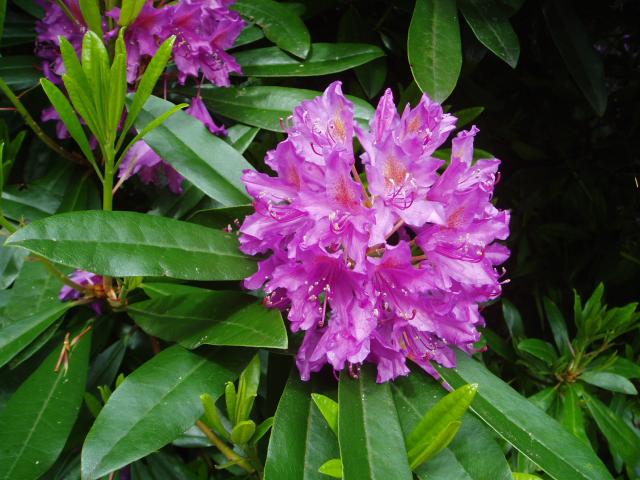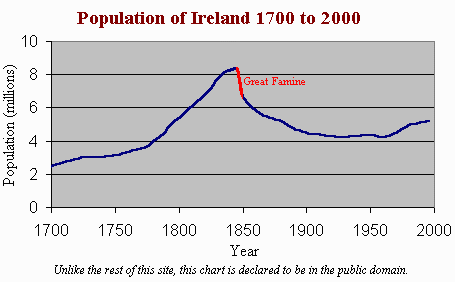The first book I chose came from Range 6: Physical Geography, Oceanography, and Environmental Science. Entitled The Irish Landscape, it's a long and rambling treatise published in 1973 on how the Irish landscape has changed over the last few million years.
Mitchell comes across as an affable great uncle, that is, if your great uncle is an Irishman who gets excited about historical pollen count diagrams. (Seriously, I think he was having some sort of contest with himself to see how many pollen count diagrams he could fit in one book.) To be fair, I have to admit Mitchell proved the usefulness of his precious pollen diagram by explaining how they showed historical shifts in land clearance and farming.
 |
| Such beauty... |
Aside from pollen diagrams, his other favorite hobby is bemoaning the leached or infertile state of Irish soils. (And then the bronze age people overworked the soil. And then the iron age people. And then the Anglo-Saxons. And then...) His favorite subject is soil, and his favorite word to use talking about them is podzolic. I guess his editor saw how excited he was about saying "podzolic" and didn't have the heart to tell him it wasn't a real word.
Between the soils and the pollen, Mitchell managed to get across some very interesting things about Ireland:
- Ireland used to be an ocean. Also, possibly a lake. Also, a huge ice-age skating rink.
- Ireland had coal deposits matching Britain, until they were destroyed shortly after their birth in the Armorican upheaval. The coal-bearing rock was, well, upheaved, leaving all the coal to be washed away by rain. This single geological event 270 million years ago changed the economic fate of Ireland come the Industrial revolution.
- Animal fossils? Sure. Plant fossils? Yep. Even evidence of tiny protists and certain bacteria? Fine. But ice fossils? Surely not. Actually, ice wedged into soil layers during the ice ages was filled in by different rock, making casts of the shape of ancient ice.
 |
| Ice wedge cast: perfection itself. |
- Speaking of fossils, it doesn’t seem that any dinosaurs were kind enough to keel over in a prime spot for fossilization. However, one kind gent left his tracks in Northern Ireland, so we know that dinosaurs did once grace the Emerald Isle.
- Ireland has excellent fossil evidence that vegetation in Europe was once on par with that of America. Several rounds of death-by-massive-sheets-of-ice caused the extinction of species out of Europe that are now distinctly American.
- Major rivers in Ireland don’t follow any kind of geological logic with their flow pattern. They cut straight through extremely hard deposits of granite instead of taking an easier route. This led geologists to conclude that they settled into their courses back when Ireland’s top layer of rock was a thick cap of chalk, which is easy to cut through. When the chalk eroded away, the rivers stayed their courses in an Apostle Paul-like fashion.
- Rhododendron, common in Ireland today following import in the 1700’s, is not an invasive, introduced species in Ireland, but rather a re-introduced one. It was abundant in forests before it got wiped out by successive ice ages.
 |
| I don't do well with ice, apparently. |
- Ireland as a landmass actually sank deeper into the Earth’s crust when it was weighed down with ice over 1000 meters thick during ice ages, meaning that sea level was at one point 4 meters higher than present.
- Ireland used to be home to bears, reindeer, wooly mammoths, hyenas, and megaceros, the great deer.
- At the height of the Roman Empire, surveyors came to look at Ireland and deemed it too agriculturally unprofitable to bother with conquering.
 |
| Meh... it's too wet here. Let's go home. |
- During the monastic age of fourth and fifth century Ireland, for lack of coinage, property was commonly valued in terms of female slaves.
- During the early Christian and dark ages, there were specific penalties assigned to chopping down different trees and bushes; if you felled an oak you were fined a cow.
- To preserve butter without refrigeration, it was buried in acidic bogs, where there were few bacteria.
 |
| Dangit, I forgot where I buried the butter again. |
- During the 17th century, trade for oak staves to make barrels reached such a peak that Ireland ran out of oak trees to cut down.
- At this same time period, the only wood left in Ireland was planted on rich estates and some farms. Lords set booby traps in their woods to catch wood thieves. Poorer farmers patrolled their woods with swords.
- Ireland has been occupied by humans for over 10,000 years, and has been farmed extensively for over 5,000 years.
- The population of Ireland (currently 5.6 million) has yet to recover from the pre-Great Famine high of over 8 million.
“It was in Ireland, during this grassland phase of the Woodgrange Interstadial, that that magnificent animal, the Irish Giant Deer (Megaloceros giganteus), reached the zenith of its success, only to be struck down, like Lucifer in full flight, by the abrupt climactic deterioration which followed.”
“Northeast Ireland was covered by ice, but it is not clear how much was of Irish, and how much of Scottish origin. The two ice-masses confronted one another here, just like two opposing sets of forwards in a Rugby scrum, and the resulting thrusting and wheeling has produced a series of glacial deposits more than usually confused.”
 |
| If we thrust and wheel enough, we could confuse some glacial deposits. |
“Variations in wind and cloud come rapidly in Ireland, and the never-ending change in the strength of the light and the value of the colour tones brings delight to the eye– and despair to the brush– of the artist.”
“At the end of the century the potato stood poised and ready to revolutionize life in Ireland.”Seriously great mental images on all of those.
Well, Mitchell, my time with you was fun, but now it's come to an end.
I promise I won't usually write this much about the books I read; it's just that this one was rather long and thus merited a rather long post.

No comments:
Post a Comment